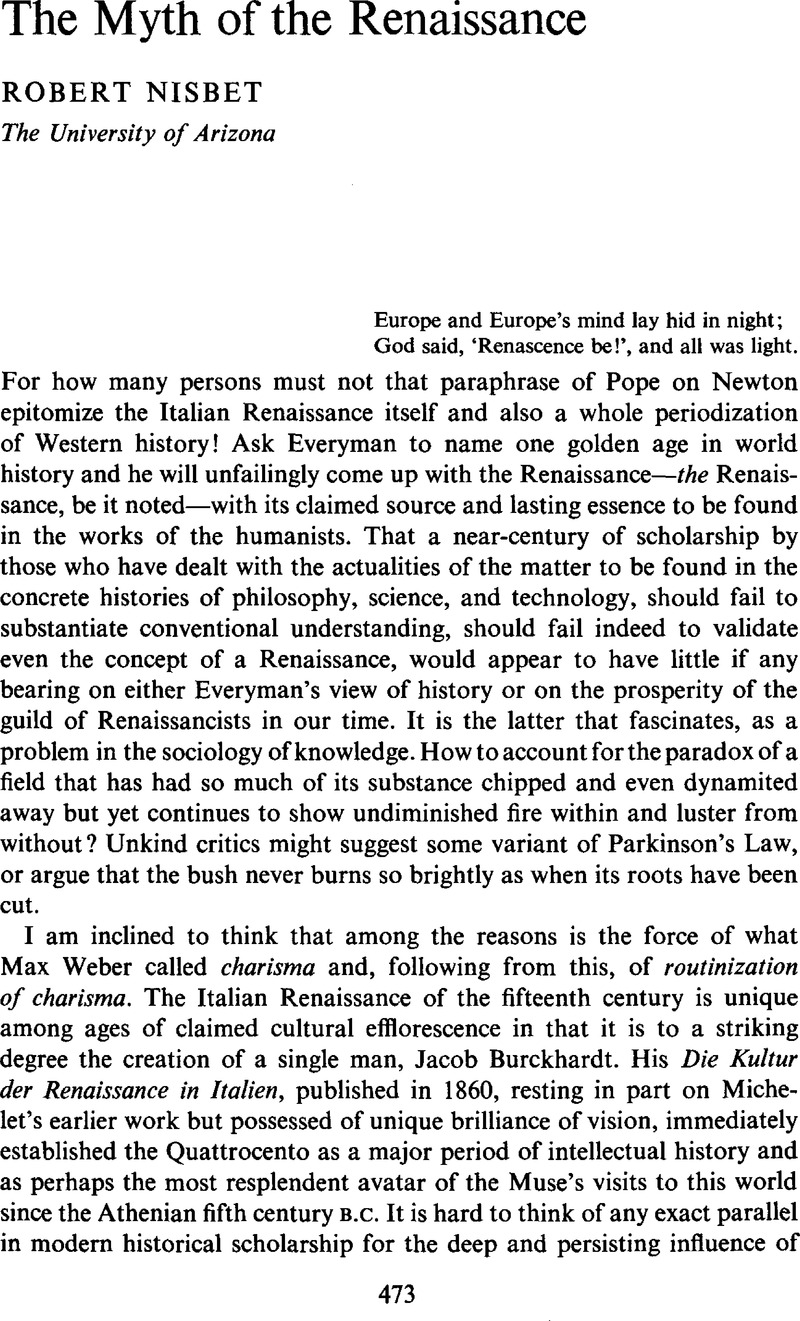Article contents
The Myth of the Renaissance
Published online by Cambridge University Press: 03 June 2009
Abstract

- Type
- Review Articles
- Information
- Copyright
- Copyright © Society for the Comparative Study of Society and History 1973
References
1 Hay, Denys, ‘The Place of Hans Baron in Renaissance Historiography’, in Molho, and Tedeschi, , op. cit., p. xxviii.Google Scholar
2 Burckhardt, J., Civilization of the Renaissance in Italy (Harper Torchbook edn.), Vol. II, p. 303.Google Scholar
3 See especially the long passage from Ficino, , and Trinkaus's commentary, op. cit., Vol. 2, pp. 482–6; also Vol. 1, pp. 193 and 240 ff., where the subjects are Petrarch and Manetti.Google Scholar
4 I have dealt in some detail with modernist use, and adaptation of the Augustinian metaphor in my Social Change and History (Oxford University Press, 1969), Chs. 2 and 3Google Scholar. On Augustine's idea of progress see the late Theodor E. Mommsen's fine essay in his Medieval and Renaissance Studies (Cornell University Press, 1959), pp. 265–98.Google Scholar
5 The City of God (Dods, tr., Library, Modern ed.), Book XI, Sect. 26.Google Scholar
6 Baron, Hans, The Crisis of the Early Italian Renaissance (Princeton University Press, 1966), pp. 460–1.Google Scholar
7 Maitland, F. W., ‘Moral Personality and Legal Personality’ in Collected Papers (Cambridge University Press, 1911), Vol. III, p. 309.Google Scholar
8 Kantorowicz, Ernst H., The King's Two Bodies (Princeton University Press, 1957), p. 245. It would be impossible to praise too highly this study in medieval political thought. Kantorowicz offers us the following quotation from the humanist Salutati, one I do not find in Hans Baron's work: ‘Thou knowest not how sweet is the amor patriae: if such would be expedient for the fatherland's protection or enlargement [sic!], it would seem neither burdensom and difficult nor a crime to thrust the axe into one's father's head, to crush one's brothers, to deliver from the womb of one's wife the premature child with the sword.’ Kantorowicz acknowledges that this is the youthful Salutati in political passion.Google Scholar
9 See especially ‘The Loom of Language and the Fabric of Imperatives: The Case of Il Principe and Utopia’, American Historical Review (07, 1964).Google Scholar
10 No one has done more than the sociologist-historian Edward Shils to give historical and comparative identity to this important class. See his just-published The Intellectuals and the Powers (University of Chicago Press, 1972).Google Scholar
11 Martines, Lauro, in his The Social World of the Florentine Humanists (Princeton University Press, 1963), has sought to show, with some success, I should say, that there is bias in this view; see especially his fascinating ‘profiles’ of some forty-five Florentines connected with humanism. Even so, I think the essential truth of the view found in Olschki, Trinkaus, Hauser, von Martin and others remains.Google Scholar
12 Sociology of the Renaissance (Harper Torchbook edn.), p. 55.Google Scholar
13 Curiously, the late Erwin Panofsky, in his ‘The First Page of Giorgio Vasari's “Libro”’, failed to grasp the Augustinian-Christian view. He declares that Tertullian and Augustine ‘refrain from extending the biological parallel beyond the stage of maturity‘. This is anything but the case. That Christ, for Augustine, represented the ‘maturity’ of the world and that the elect would pass from this world to endless bliss in no way offsets Augustine's conviction of the decay, degeneration, and eventual death of culture and society in this world. Panofsky's error seems to stem from reliance upon a book he himself terms ‘inadequate’, and which assuredly is: Kleinsorge, J. A., Beitrage zur Geschichte der Lehre vom Parallelismus der Individual-und Besamtentwickling (Jena, 1900).Google Scholar
- 2
- Cited by




